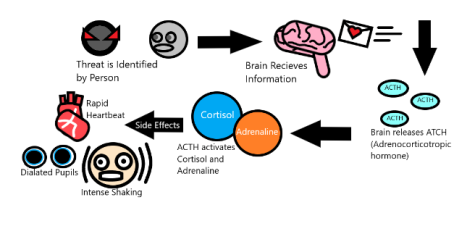LOCKDOWN!… Nevermind
How fight or flight instincts work, and how they walked students through the non-drill lockdown.
On Tuesday, February 7th when the familiar and eerie sounds of lockdown bells started blasting during the third lunch, instincts kicked in for students seated in the cafeteria. Even though the alarm was an accident, the whole event provided a look into a real-time example of the system that activates a large wave of emotions within the student body, leading to acts of pure instincts. At approximately 1:47 pm that day, the lockdown bell rang. The problem? It wasn’t a planned drill. In fact, no one in the building at the time knew what was going on. Classrooms went through the regular lockdown procedures, but in some way it felt off.
Freshman Jonah Mannon, who was in class in the south hallway at the time, believed it was a real lockdown, and went about the lockdown routine as usual.
“I just thought about getting in the corner of the room and just crouched down. I did think something was happening for a couple of minutes until they announced it was fake,” he said.
Everyone in the hallways was rushed into the cafeteria. Many promptly left through the back doors and started running away from the school, to cars, or to anywhere that could offer them protection. Around 20 minutes later it was confirmed that the alarm was a mistake, and the school went into a hold.
That day, Eastridge Community Elementary planned to do a lockdown drill and when it was triggered from Cherry Creek District Headquarters, the Eaglecrest High School button was pushed instead, thus causing the panic.

The instinct to flee the school comes from the fight or flight reaction. During this process, the ears and brain send signals of incoming danger to the amygdala which is responsible for emotions in the brain. Once the brain interprets outside stimuli as dangerous, it sends a signal to the hypothalamus to get the body ready to protect itself. The brain then communicates via the nervous system and blood starts pumping to the muscles in order to give them either extra strength for fighting or extra speed for fleeing.
In the event of a situation like the one that the EHS student body found themselves in on Tuesday afternoon, fight or flight came into play for many students when deciding what to do, and if there was a threat in the building.

Caleb Barnett is a Junior entering his second year with Nest Network. He enjoys playing the guitar and bass guitar, and even builds them. Caleb really...















